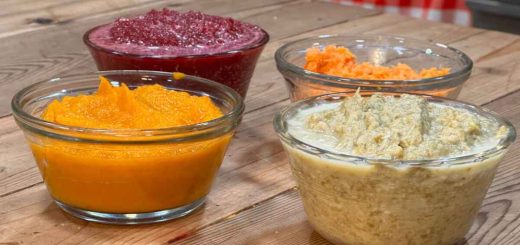Chat recipe without butter in the oven: light and tasty recipe
healthy and healthy recipes. Fragrant, crunchy and a good compromise: chatter without butter and without frying.
Ingredients:
-1 egg
-150 g of flour
-1 tbsp sugar
-1 spoonful of white wine
-1 tablespoon of seed oil
-Grated peel of one lemon
-1 tablespoon of mixed seeds
-1 pinch of salt
Method:
To prepare the chat recipe without butter, gather all the ingredients in a bowl: first the flour, then the sugar, an egg, the seed oil, the wine, the grated peel of a lemon, a pinch of salt.
Mix everything until a soft and homogeneous paste is obtained. Form a ball, wrap it in plastic wrap and let it rest for 30 minutes in the refrigerator.
After the necessary time, roll out the dough with a rolling pin. (or even better with the pasta machine). Until you get a thin sheet;
With the help of a notched wheel form the chatter.
Finally, take a baking tray lined with parchment paper. Lay the chatter on the top and bake at 200 degrees for 10 minutes.
A bit of history: where the Chat recipe comes from
When we talk about carnival we immediately think of the chat recipe also called lies, frappe, rags or gorges according to the region; the origin of this dessert dates back to Roman times to celebrate the Saturnalia (a holiday that corresponds to our Carnival).
At that time Roman women prepared desserts called “frictilia” based on eggs and flour fried in animal fat (typically pork fat).
It was a very simple recipe based on inexpensive ingredients. So much so that they were prepared in large quantities to be distributed to the crowd who came to celebrate on the streets of the city.
The tradition of frictilia has been handed down over the years with changes to the basic recipe.
Today, these fragrant sheets are typically fried in oil and no longer in lard. But the typical elongated shape and slightly rounded at the edges has remained.
The butter-free chat recipe offered is even lighter, thanks to baking that is certainly healthier.
Difference between saturated and unsaturated fats
Lipids are a heterogeneous group of water-insoluble organic molecules and represent an important source of energy for the body: in fact, 1 gram of lipids provides about 9 kcal.
The most variable part of the lipid molecule is represented by fatty acids. The fatty acid chains can be free of double bonds, i.e. be saturated, or contain one or more double bonds, and therefore be mono or polyunsaturated.
For the preparation of the carnival chat recipe, I replaced two lipid sources, butter with seed oil.
The difference between these two types of fats lies in their structure, origin, and effect on the body.
All fats are equal in terms of energy supply, but in terms of quality they can be very different; seed oil is fat of vegetable origin rich in unsaturated fatty acids defined as “good” while butter is an animal fat containing saturated fat called “bad”.
The different quality of fats can have important effects on human nutrition and health.
How to take fats optimally
The general rule is now well known to all: an excess of saturated fatty acids in the diet corresponds to a greater risk of developing a series of diseases, among which cardiovascular diseases stand out.
Foods with a high content of saturated fatty acids tend to raise the level of cholesterol. Among these foods include dairy products (cheeses, whole milk, cream, butter), fatty meats. And their derivatives and certain vegetable oils (palm oil and coconut oil).
Foods with a high content of unsaturated fatty acids. On the other hand, do not raise the level of cholesterol in the blood. These foods are mainly represented by vegetable oils (seed and olive), nuts, hazelnuts, dried fruit in general, oilseeds, avocado, olives, and fish. Unsaturated fats include both monounsaturated and polyunsaturated fats.
Seed oil is generally rich in omega-6 polyunsaturated fats, called “essential fatty acids” because our body is unable to synthesize them. Therefore we must take them through food sources.
According to the most recent recommendations. It is necessary that in our diet fats are present on average in such a way as to provide an amount between 20-25% and 30-35% of the total daily calorie content.
As for their quality, the suggested breakdown is as follows:
Saturated fatty acids: no more than 7-10% of total calories
Monounsaturated fatty acids: up to 20% of total calories
Polyunsaturated fatty acids: about 7% of total calories with an omega-6 / omega-3 ratio around 5: 1
















